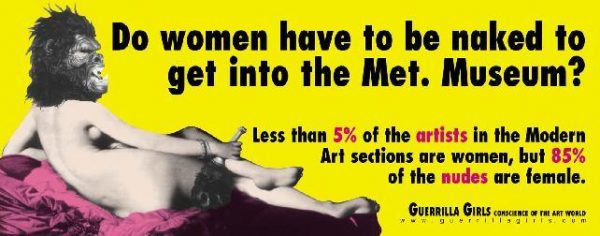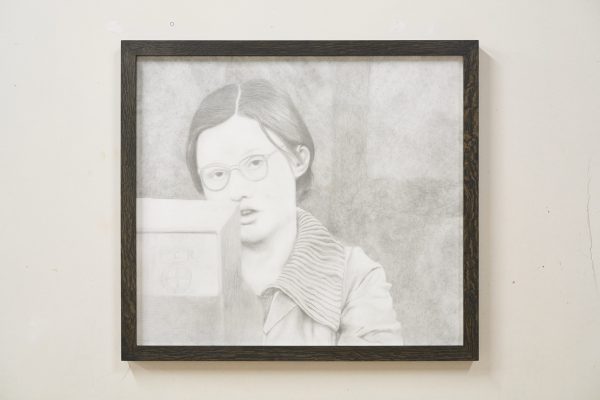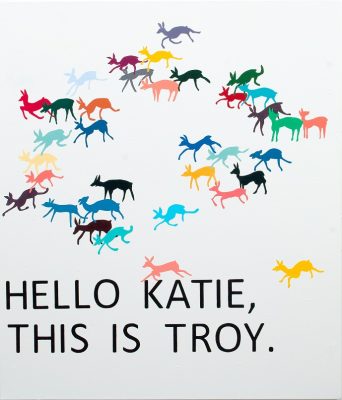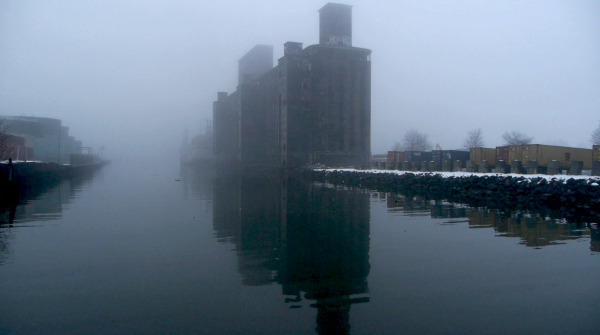London is among the capitals of the international art world. Every day and night is witness to innumerable new exhibitions, openings, events, performances and screenings. Having established itself as a world centre for the exhibition and sale of contemporary art, the past decade has seen an exponential increase in its number of galleries, with commercial and non-profit spaces springing up across the city. Yet the majority of these venues continue to privilege the work of male artists, begging the question of how gender equality has figured in this boom. When we are moving at such a fast pace, why are women artists being left behind?
The East London Fawcett (ELF) – a branch of the Fawcett Society, the UK’s leading campaign for gender equality – recently gathered a body of statistical data in the form of the Great East London Art Audit. This information was collated over the course of a year by volunteers, researchers and statisticians with the aim of providing an objective overview of the status of women artists. The results were clear: of the 134 commercial galleries in London that were audited, which collectively represent 3163 artists, 31 per cent of the represented artists were women. Further to this, only 5 per cent of the galleries represented an equal number of male and female artists, with 78 per cent of the programmes representing more men than women. ELF also audited the 133 solo shows featured in 29 of the city’s non-profit institutions and galleries, finding that, identically, 31 per cent of these exhibitions were by female artists, while only 1 of 29 galleries presented an equal number of male and female solo shows in that time frame.[1]
The continued imbalance of gender representation within the arts is an issue all too often ignored. The lack of tangible urgency compares unfavourably with the 1970s, when a number of art movements in North America and Europe critiqued patriarchal power structures and explored the social and political impact of identity, gender and sexual difference. During this period, statistical information gathered by activists in Los Angeles revealed that over a period of ten years, of 53 one-person shows mounted at the Los Angeles County Museum, only one had been by a woman. Strategies were implemented to address female under-representation, with galleries, exhibitions and journals being established by women for women – art historian Linda Nochlin published the influential essay ‘Why Have There Been No Great Women Artists?’ in 1971 and New York’s A.I.R Gallery was opened in 1972, providing exhibition space for women during a time when most commercial galleries showed the work of men.
In a recent interview with Der Spiegel the German artist Georg Baselitz said ‘women don’t paint very well. It’s a fact,’ and further to this stated that they ‘simply don’t pass the market test, the value test. As always, the market is right.’ It is hard to take such a statement seriously in the twenty-first century, but statistical data does reveal that of the top 100 auction performances in 2012, none was for a work by a female artist. Furthermore, of the 3441 artists represented across the 135 commercial galleries at the 2012 Frieze Art Fair, 27.5 per cent were women, with only 3.7 per cent of the galleries having equal gender representation. The market certainly suggests that male-dominated power structures persist. How might this reflect the attitudes and beliefs within today’s society regarding the true ‘value’ and legitimacy of work by women artists?
While the statistics reveal that women artists in London are still outnumbered by their better-paid male counterparts, there is at least an improvement on the situation for women artists forty years ago. So should we be pessimistic at the continual struggle, or encouraged that some progress is being made?
To discuss the continued under-representation of women in London’s contemporary art world, the characteristics of this situation and the potential for progress, I interviewed a number of women working across the visual arts, including Frances Morris (Head of Collections, International Art at Tate Modern), Sadie Coles (the founder and director of the influential London gallery Sadie Coles HQ), Goshka Macuga (a London-based Polish artist and 2008 Turner Prize nominee) and Valeria Napoleone (a contemporary art collector who focuses on work by women artists).
Frances Morris noted that ‘if you take a snapshot of the women artists in Tate’s collection after 1965, there’s a similar [figure of] 30 per cent, which is a massive improvement on the historical collections; 1900-65 is 19 per cent, and if you look back prior to that, it’s 1 per cent’. So perhaps we should be encouraged? Sadie Coles is adamant: ‘I think it’s changing, and I actually see things positively because I think there are many women artists making a very strong place for themselves in both the commercial and non-commercial sectors. I feel that it’s an upward curve as opposed to a downward one and I just want to concentrate on that.’
I can’t help but persist in wondering about the factors that perpetuate the marginalisation of women artists and obstruct equal gender representation. In a recent article in Art Monthly, Jennifer Thatcher quoted Higher Education Statistic Agency figures revealing that women made up 61.7 per cent of the art college undergraduates to obtain a degree in 2011-12. The fact that more women than men graduate throws a sharper relief onto the imbalances that emerge in their careers thereafter. In seeking to explain why so few women gain the success as artists afforded their male peers, Thatcher concentrates on the restrictive pressures facing women: ‘Women… express anxiety at the prospect of having children, feeling that they must avoid visible obstacles to their career progression in a world in which one must appear continually available for residencies, commissions or even just networking.’ Coles agrees that ‘women have other choices; children do have an impact on the amount of time that you can spend in the studio and jetting around the world.’
Valeria Napoleone’s collection has developed according to ‘the criteria that the artists are absolutely relevant to our contemporary language. They also happen to be women, and this has become a political element that is as essential to the collection as my own taste and personal reaction to the work’. In an interesting development on the above points, she feels that ‘women are penalised by the art market because of the element of time. Time is the factor that is most valued by the art market: speed. Women tend to work at a different pace.’ Women suffer from a lack of time being available to them in a system in which motherhood and career continue to be treated as mutually exclusive. Women battle with time: from the length of time that it has taken to escape the domestic space and enter the workplace, to the remaining time necessary to meaningfully deconstruct the socio-economic structures that so heavily favour men.
Coles highlights that ‘the top auction results are a different generation of artists. That will naturally change as time goes on. Certainly some of the older women artists are actually achieving quite good prices now’. The rise in value of works by artists such as Louise Bourgeois (whose ‘Spider’sold for $10.7m in 2011), Agnes Martin and Yayoi Kusama suggests that the imbalance in sale prices might slowly equalise. But how much more time is it going to take? And is the argument that time redresses all imbalances ultimately just an illusion that neutralises active empowerment? Coles continues: ‘the market is completely subjective, it’s not objective. You can’t make a lot of rules that people are going to follow. It’s actually a case of how do you define a great artwork; it’s a judgement that everyone makes, collectively, and that’s what defines it. But there aren’t any hard and fast rules’.
So what are the factors that shape the ways in which we collectively define a great artwork, and could one generalise to suggest that women and men make different kinds of work? If there are no hard and fast rules, why is the work of male artists still deemed to be of more ‘value’ by our art markets and institutions? Women have, over the past hundred years, tended to work outside of the mainstream. It’s this mainstream that occupies the market place and that represents power and conventionally-received, western-centric art history. So the work of women operating on the margins has not impacted the centre where there is a vested – often financial, economic – interest.
Morris discusses how ‘Lucy Lippard defined the plinth and pedestal syndrome and those works that draw the marketplace; women have tended not to address working in those ways because they’re seen as the bastion of male creativity’. She also draws attention to two other factors that can, at times, govern the interpretation of a female artist’s work by the academe: the ‘assumption that women’s work is going to be about themselves’ and the fact that, in art historical literature, ‘technical or formal characteristics of certain types of works are assumed to be feminine: smallness of scale; lightweight; delicacy; sewing; craft.’ Elaborating on the former, she clarifies that ‘sometimes it [the methodology of biographical interpretation] may be because the artists themselves have leant that gloss; Bourgeois deliberately brought her biography into play as a control mechanism’.
Goshka Macuga creates sculptural installations that could be described as resolutely not fitting those characteristics that might reductively be defined as feminine. Her works gather together disparate objects and documents, forging narratives that explore the relationship between aesthetics and politics. She notes that, in comparison to other sectors of society, the situation in the art world is ‘not that bad’. She cites her participation in the British Art Show (2005): ‘the first curatorial meetings that I witnessed were all about equality and you had to have the same amount of women and men. There was a whole breakdown, numbers that they had to meet. This is how you got funding in this culture at this time.’ Indeed, when you look more broadly across the socio-political and cultural sectors, the statistics become more shocking than our 31 per cent: in FTSE 100 companies, only 17 per cent of directors are female, and women are outnumbered four-to-one in parliament, five-to-one in the cabinet.
Macuga’s interests in this issue lie mainly in the political implications of western exhibition models being implemented across the globe, and how these do or don’t provide opportunities for non-western populations – both men and women. She discusses the ever more globalised art scene and the growing culture of biennales and art fairs, noting that many of the biennials take place in countries ‘which are politically and economically problematic or in crisis, and it is about the projection of one context into another; trying to impose some western idea of how inspirational art can be to those people and then leaving that place and not taking any responsibility for the idea of intellectual freedom they have proposed.’ She links the notion of equal representation for women to that of the spread of neo-liberal values: ‘in terms of disadvantages between women and men, it starts becoming a bigger issue in certain areas. So the question is: do you bring your existing western codes and impose them there, meaning colonising it and implementing a system that we are all familiar with, spreading it, or do you go there and really consider that context?’
While she is concerned about how this expanding western model of art exhibitions, fairs and biennials might or might not stimulate social change, one could also argue that the deconstruction of western-centric narratives is in fact aided by this outward expansion. Morris describes how ‘the western paradigm is now shifting, so it’s not all about European and North American art. If you start chipping away at the core, in geographical terms, then I think gender has a better chance of getting in as well. That master system and narrative is collapsing.’ So the break up of western dominance, and its associated systems and traditions, might allow the shift into a more heterogeneous, open model. As art from places previously excluded from mainstream discourse is allowed in, so too might women artists benefit – who have traditionally operated on the fringes.
Would introducing quotas for acquisitions and displays within museums hasten this process? Morris points out that ‘if you implemented a 50 per cent rule in our collection displays, we’d probably be drawing on a fifth of the collection to represent 50 per cent of the display, which would have a grossly distorting affect.’ She outlines how the exhibition programme is a means to hasten the legitimisation of work by women artists. By putting on exhibitions by Ellen Gallagher and Saloua Raouda Choucair now, she points out, the artists’ profiles are raised and the public prepared for their incorporation into the permanent collection. This tactic is, however, being hampered by the funding cuts that make blockbuster exhibitions of already-popular artists a financial necessity. Nevertheless, institutions have a responsibility to ‘create visibility – they’re only going to rewrite Yayoi Kusama back into history now that she’s had a major exhibition at the Tate.’
The art world is structured in such a way that collectors who purchase works through commercial galleries often sit on the boards of museums, contributing to acquisition funds and ultimately donating their own collections to public institutions. I ask Valeria Napoleone whether she would agree that art collectors have an important role to play in helping to deconstruct the existing western power structures: ‘The collector absolutely has a lot of power. If collectors start buying the work of women artists and supporting them, and if new art buyers start looking at work by women, things would change. It’s supply and demand. The collectors look at museum exhibitions; if they see an artist in a show they think, I’ll start buying it. And then the galleries follow as well’. Here we have a two-fold strategy, according to which museums give women artists (both emerging and established) exhibition time in order to stimulate a response from collectors, and following that, commercial galleries.
Progress in redressing the under-representation of women artists is slow. This is perhaps in part due to art’s status under capitalism as a high-end, luxury commodity in which there is a vested market-led interest in maintaining twentieth-century hierarchies. Indeed, it could be argued that neo-liberal feminism operating within today’s model of capitalism privileges the individual over the collective, and is disenfranchising women artists by placing too much emphasis on autonomous agency rather than political agency as a group. The dialectic between a female artist’s individual subjectivity and group action is constantly being mediated, diluting the potency of the struggle and the voice of discontent. To focus too heavily on statistics though is, as Morris concludes, to miss a crucial point: ‘it’s not just about volume, it’s really about demonstrating that work by women is just as good. We need to create some kind of a network; we need to know what each other is doing and reflect on what that means’.
We need to establish a network of professionals committed to the promotion of art by women. As an increased number of female curators, gallerists and museum directors gain influence – already in London The Whitechapel Gallery, Camden Arts Centre, South London Gallery, Serpentine Gallery and Chisenhale Gallery are run by women, alongside an increasing number of female gallery founders including Victoria Miro, Maureen Paley, Alison Jacques and Hannah Barry – we must expect the gender balance between male and female artists to follow suit. But the dismissive and all-to-often encountered passive assumption that time will naturally redress this situation is a dangerous one. Under the current system, it won’t, at least not at the rate it should. But, as Sadie Coles says, we must be positive: positive that through energised dialogue and action we can reshape the normative structures that continue to subjugate women artists.
[1] For further information on ELF and the Great East London Art Audit, please visit: http://elf-audit.com/the-results/




